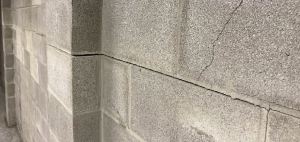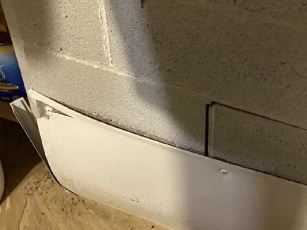Over the years, I have seen a lot of cracks. Big cracks, small cracks, long ones, and short ones. I’ve seen cracks of all different shapes and sizes. I should make it clear that I am not a crack expert. Before I go on, I should also make clear the type of cracks I am referring to. Settlement cracks!
When performing an appraisal observation, appraisers must look for settlement issues and report on them. Especially if they are believed to be indications of major structural problems because this has an impact on value. Cracks are one indication of possible settlement issues. Cracks develop when stress upon a dwelling exceeds its strength. There are many potential causes. Changes in moisture, seismic load, foundation settlement, and even changes in temperature.

Perhaps the title of this article makes you think of the comic series from the 1942-1949 named the “Crack Detective“. Well, probably not. At times it does take a little detective work to determine what the cause(s) might be. We must ask several questions in our investigation. Why are the cracks there? When did they begin? Are they getting worse? Do they require repair?
Let’s first talk about the two fundamental types of settlement cracks. Structural and non-structural. It should be noted that sometimes a crack may appear to be structural, when it is not, and visa-versa. That’s one reason why a qualified professional is sometimes needed to make this determination.
There are also numerous types of cracks. Masonry, shear, flexural, torsion, corrosion, shrinkage, column, vegetation, and sill cracks, to name a few. I’m not going to delve into these in detail in this post. I did find a video that addresses all these types of cracks. I have shared it at the end of this article.
Let’s talk about the basis. What constitutes a structural vs. non-structural crack?
STRUCTURAL
Structural cracks indicate that there is something is happening with the structure of the home, as the name implies. It could be bowing or settling foundation walls. Based upon my research, structural cracks usually start in a corner and travel down at around a forty-five degree angle. Structural cracks may also run horizontally across a foundation wall. In the picture on the left, you can see both types of cracks. There is a horizontal crack running along the foundation wall, as well as a shear crack, running at a forty-five-degree angle along one of the cinder blocks.

Structural cracks do not always require repair. Especially if the gap in the crack is relatively minimal, and it appears to have settled to a degree that it is no longer getting worse. I like to ask the homeowner how long the crack has been in existence and if they have noticed it getting worse.
However, at other times, the settlement may need to be repaired due to the structural integrity of the foundation being compromised to a degree that it requires repair. A qualified professional is sometimes needed to determine if a repair is necessary. In the photo to the left, a qualified professional did determine that major foundation repairs were necessary.
Structural cracks can sometimes be repaired using wall plate anchors or steel driven push piers. Of course, sometimes, the foundation wall needs to be replaced. There are a lot of variables to consider in this situation. Appraisers are not qualified to make these determinations. So, we will call for an qualified professional to inspect the situation to see what, if anything, needs to be done. It is impossible to know the impact on market value until we know if repairs are needed.
NON-STRUCTURAL
Non-structural cracks are usually created by the expansion and retraction of a foundation due to changes in temperature. Non-structural cracks can also be caused by a large amount of water in concrete, mortar, or cinder block, which may cause shrinkage. Shrinkage from water or other materials, may cause cracking. Often, based upon my research, a perfectly vertical crack in concrete is caused by this type of situation.
Non-structural cracks usually do not require repair. If they do, usually it is only to fill the gap, which can be achieved by using carbon fiber straps or epoxy injection.
CRACKS CAN TELL A STORY
At times, cracks can tell us a story about when they started. There may also be some indicators as to whether the problem is getting worse. In the pictures below, what do you see? Do you see evidence of the cracks getting worse?

These are pictures of some settlement cracks in homes I’ve appraised. The picture on the left shows that this basement has been waterproofed. Therefore, right away it seems likely that the foundation has some moisture in it, which is not in itself problematic.
However, the settlement, which may be caused by this moisture, has caused the waterproof sheathing to pull apart at the corner. What does this indicate about this crack? This may be an indication that the settlement took place after the basement was waterproofed, which may be an indication of this being a more recent crack, that is potentially still getting worse.

Check out the picture on the right, from the same basement. Notice that at some point, someone caulked the settlement cracks. However, since that time, the caulking has pulled apart. This may be from simple expansion of the foundation due to differences in temperature. However, this could be a sign that there is further movement in the foundation. The foundation crack may be getting worse.
Not all settlement cracks are major issues. As I mentioned in my introduction, I have seen a lot of cracks over the years. Sometimes, after a home is built, parts of the foundation may settle a little. But then, the settlement may stop. This is common in many homes and is not necessarily something that needs to be repaired. The next picture on the left is of a foundation that has some settlement cracks in the mortar. The homeowners have stated that these cracks have been in existence for decades. Notice that they are running along the mortar. It appears that there are non-structural cracks and are assumed to not be an issue.

What if a basement is completely finished, and the foundation cannot be viewed by the appraiser? Can there be other visible indications of serious settlement in other areas of the home? Yes indeed!
If there are major structural issues, there may be evidence of this on the exterior portions of the foundation. Sometimes it’s easy to see a bowing foundation wall. Additionally, on the interior, if there are cracks in the brick, that is often a sign of settlement.
There may be cracks on the interior walls or ceilings, which could be evidence of some settlement. Of course, like cracks in the foundation, simply having a crack on a wall or ceiling is not necessarily proof that there are structural issues. Furthermore, as already mentioned, sometimes, this settlement may have taken place early in the life of a home, and may have since stopped. Therefore, even if cracks on the walls or ceilings exist, it may not necessarily mean that there is an ongoing problem. A qualified professional may be needed to make a further examination.
If an appraiser feels like the cracking in the foundation, walls or ceilings is a sign of something more ominous, they will call for the foundation to be inspected by a qualified professional, to determine if any repairs are needed. However, this does not need to be done just because some cracks are observed. Because major structural repairs have a negative impact on market value, we must take this situation seriously.
Remember, if you develop a crack, on your house that is, do not panic! It may not be a big deal. A little investigation work will be needed to figure out what’s going on. That’s all I have to say about cracks. Hopefully, this post gave you some food for thought.
Here’s that video that discuses the different types of cracks I mentioned earlier, and their potential causes and possible remedies.
Looking for a qualified real estate appraiser in your area? Go to www.FindMyAppraiser.com

If you enjoy listening to podcasts, check my new podcast out. I hope you enjoy it! You can find me on Apple Podcast, iHeart Radio, Spotify, Google Play Music, Sound Cloud, Radio.com, RadioPublic, Deezer, Breaker, Stitcher as well as other feeds.
You can also listen right here at Cleveland Appraisal Blog!
 www.homevaluestories.libsyn.com
www.homevaluestories.libsyn.com
If you are interested in stats, and nothing but the stats, for neighborhoods in Northeast Ohio, check out my other podcast. In it, I provide short episodes that provide you with stats on median sales prices, marketing times, housing inventory and other related stats, on specific neighborhoods in Northeast Ohio. You can find me on Apple Podcast, Spotify, Google Play Music, Breaker, Overcast, Pocket Casts, Radio Public or you can listen right here at the Cleveland Appraisal Blog.
www.anchor.fm/cash-appraiserstats.com
Here are some links to other articles I’ve enjoyed recently! I hope you will also…
The Shapes of Words In The Language of Housing – Housing Notes by Jonathan Miller
Surplus vs. Excess Land for Appraisals – APPRAISAL TODAY
A Case of COVID, 2020, and Birmingham Real Estate – Birmingham Appraisal Blog (I’m grateful that my friend Tom Horn survived COVID and is blogging again!)
Anatomy of a Sales Comparable – Birmingham Appraisal Blog
My new sewer line adds huge value, right? – Sacramento Appraisal Blog
Modernized Bias – and Opinion? – George Dell’s Analogue Blog
Mayo Clinic What is happening now – Vaccine Rollout, Variants, and much more. – Covid Science for Everyone
What a Newbie Needs to do! – Tim Andersen, The Appraiser’s Advocate Podcast
A Realtor, a Lender and an Appraiser Walk Into a Bar – Appraiser eLearning Podcast with Bryan Reynolds





Hey Jamie,
Great, useful post. Thanks for putting this together.
Thanks Joe! My pleasure! I hope you all are doing good!
Appraisers have to use good judgement here, though it’s an interesting situation to use judgement on something that is really not within the wheelhouse of the appraiser’s expertise too.
So true! It is tricky. I think the important thing is to simply report our findings and any assumptions we are making as well as our rationale for them.
Thanks for the great article, please forgive my ignorance but who would call for such a problem? A structural engineer, what type of company repairs this sort of issue?
Thank you! Great question! If an appraiser sees a potential issue, we will have our report made ‘subject to’ an inspection by a qualified professional. You are correct. Usually a structural engineer would be hired by the homeowner to determine if a repair is necessary. If foundation repairs are needed, there are companies that specialize in foundation repairs. Some settlement cracks are common. Not every crack is indicative of a major issue. It’s a judgement call on the part of the appraiser as to whether further investigation is necessary. Hopefully that helps! Thanks for writing in!